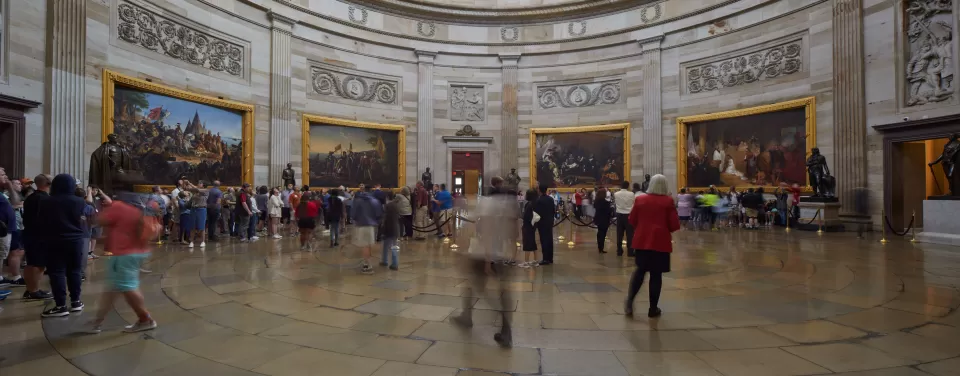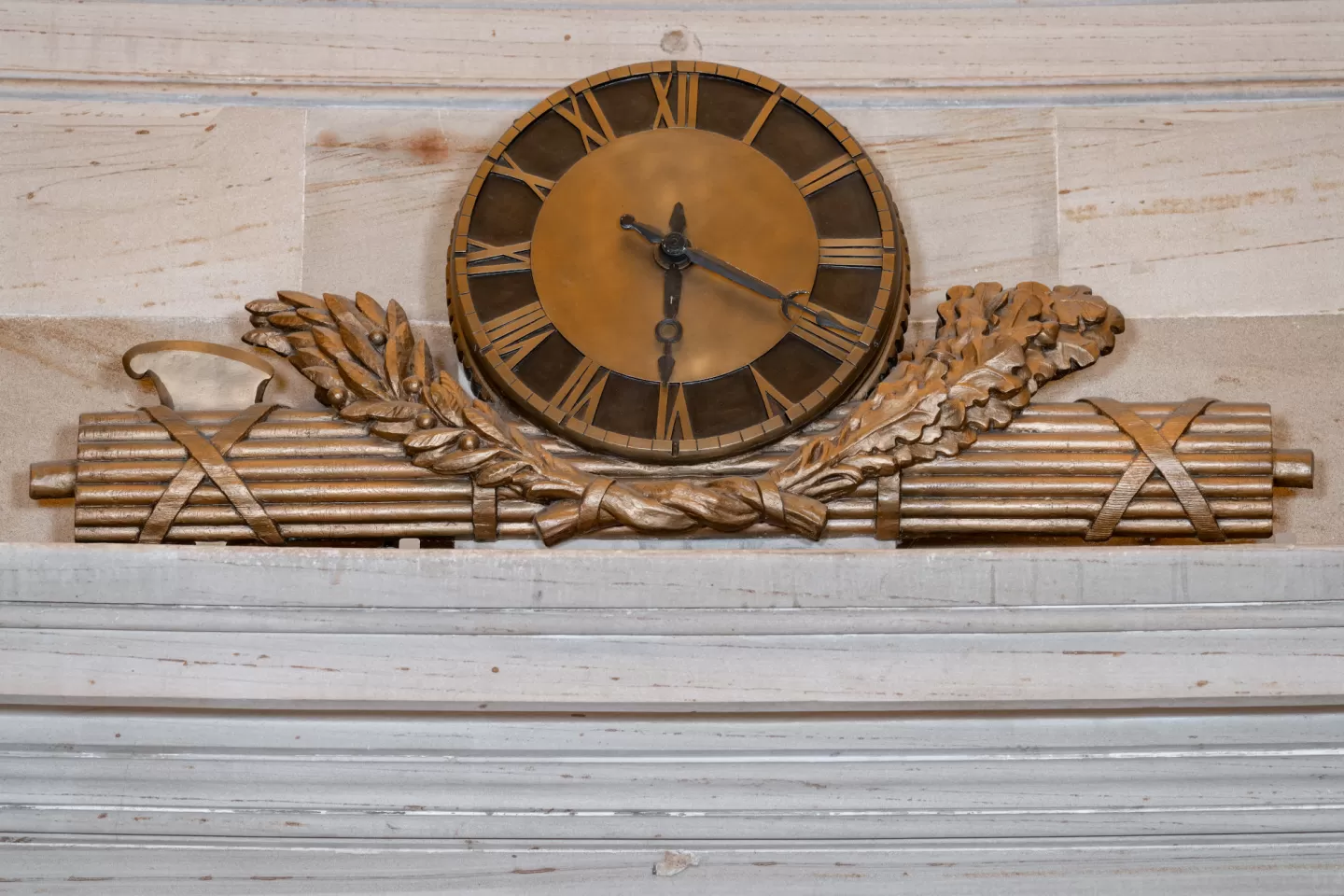The clock sits on a base composed of a wreath and fasces, a Roman symbol used throughout the Capitol that represents authority or law. In the early American republic, fasces also represented the strength of the states when united. The wreath below the clock face is made of laurel and oak branches. Typically, laurel represents honor or victory, and oak suggests strength. The bronze dial has Roman numerals, and the clock hands are also finished in bronze.
History
Though the clock is now placed in the Rotunda, Lawrie originally designed it for the renovated Senate Chamber in 1950. The 1949-50 renovation involved replacing the roof, installing new ceilings and remodeling the gallery level during the first phase of the work. During the second phase, the lower part of the chamber was remodeled. As part of this phase, the Architect of the Capitol contracted Lawrie to model "an ornamental bronze clock" to be placed above the rostrum and three "sculptured marble panels" to be placed above three of the doors.1
The clock was intended to hang above the rostrum on the front of a parapet at the base of the press gallery. Architect of the Capitol David Lynn emphasized the importance of maintaining clear sight lines from the gallery to the chamber floor below. Architect John Harbeson, of the project's consulting architectural firm Harbeson, Hough, Livingston & Larson, prioritized the architectural integrity of the entire chamber. The project's associate architect, Francis P. Sullivan, contributed sketches and feedback throughout the process.
The architects and the artist workshopped design ideas through letters as well as occasional phone calls and studio visits. Lawrie first suggested incorporating fasces in the design, and Harbeson proposed its use in the base of the clock. In a letter to Sullivan, Lawrie wrote that the design included "symbols for Law, Strength and Honor in the use of the fasces, oak and laurel."2
In October 1950, Lawrie agreed to model a second bronze clock for the Senate Chamber, to be placed opposite the rostrum above the south door. There was less discussion about this clock's design. Along its base, Lawrie employed a common strategy to depict the passage of time: a moon and two stars on one side and a sun with rays extending outward on the other.
Roman Bronze Works cast both clocks, and Self Winding Clock Company, Inc. made and installed the interior works. The clocks were completed in time for installation on December 29, 1950, but only the clock opposite the rostrum was placed. Records are not definitive about whether the clock above the rostrum was ever installed, but if it was, it did not remain there for long. Immediate objections from either (or both) members of the press and Sen. Theodore Green, part of the committee overseeing the renovations, meant the space above the rostrum remained empty. The clock was placed in storage.
By mid-January 1951, Sullivan was already suggesting alternate designs for a new clock, and Lawrie submitted a sketch in April for a square bronze clock flanked by eagles. Both Sen. Green and Harold R. Beckley, superintendent of the Senate Press Gallery, approved the new design. Bedi-Rassy Art Foundry and Self Winding Clock Company, Inc. fabricated this clock. It was installed by mid-August 1951 and remains in the Senate Chamber today.

In the early 1960s, the Architect of the Capitol was replacing clocks in various locations throughout the U.S. Capitol. When the agency received yet another complaint about the jarring red clock in the Capitol Rotunda, Assistant Architect of the Capitol Mario Campioli suggested replacing it with the original Lawrie clock. It was removed from storage and refinished, including the installation of an electronic impulse movement. It was placed above the East Door of the Capitol Rotunda on February 9, 1965.
Artist
Lee Oskar Lawrie (1877-1963) was born in Germany and moved to the United States with his mother when he was four. Around age 14, he found work assisting sculptor Richard Henry Park in Chicago; he helped build armatures and maintain the clay. He assisted sculptors working on the 1893 World's Columbian Exposition. After the exposition, he began working on his own while continuing to apprentice with prominent East Coast sculptors. He studied and taught at the Yale University School of Fine Arts and taught at the Harvard School of Architecture. At the time of this clock's commission, he was serving on the U.S. Commission of Fine Arts.
Lawrie's most acclaimed work includes the architectural program inside and outside the Nebraska State Capitol and at the Los Angeles Public Library, both part of his long-term collaboration with architect Bertram Goodhue. Lawrie's many artworks at Rockefeller Center in New York City include the statue of Atlas. These projects all showcase the combination of modern art styles with classical figures that made Lawrie one of the country’s top architectural sculptors. Lawrie worked in multiple 3D formats, and his style evolved over time, reflecting changing modernist approaches and a sensitivity to the needs of individual projects. In addition to the bronze clocks and marble panels for the Senate Chamber renovation, he sculpted the bronze doors for the Library of Congress Adams Building.
1. Contract, February 1950, Art & Reference Files, Curator for the Architect of the Capitol.
2. Lawrie to Sullivan, June 27, 1950, Art & Reference Files, Curator for the Architect of the Capitol.
